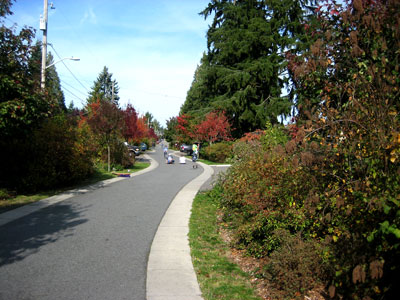Learning from Seattle: A Lesson in Sustainable Design Part 1
Thu, May 28, 2009 Andrew Wickham stormwater runoff, bio-swales, sustainble design, green design, LEED
Seattle is one of many cities embracing a sustainable future and actively pursuing it. From LEED certified buildings to experimental storm water run-off systems, the city is looking for ways to lessen its impact on the environment. During my last visit, I was fortunate enough to explore some of these steps in the "green" direction.
Street Edge Alternatives (SEA), as the city has dubbed them, are  several experimental urban streets that have been designed to shy away from the accepted norm of sheet flowing water to a curb, running the water along a gutter, catching it in a giant storm drain, then piping it to the most convenient location (usually a body of water). Though efficient, this method usually ends up with increased pollutant levels within the water system, it increases in flood events (magnitude and frequency), and experiences a decrease in aquifer recharge-all, of which are not exactly beneficial. Seattle has tasked designers to explore alternative methods for essentially achieving the same thing: removing water from the street as quickly as possible. Furthermore, the city upped the ante by adding a few additional requirements: clean the run-off, recharge the aquifer, and minimize the amount of water put into the already stressed storm drainage system. The result? Several developments with less-than-ordinary means for dealing with storm water.
several experimental urban streets that have been designed to shy away from the accepted norm of sheet flowing water to a curb, running the water along a gutter, catching it in a giant storm drain, then piping it to the most convenient location (usually a body of water). Though efficient, this method usually ends up with increased pollutant levels within the water system, it increases in flood events (magnitude and frequency), and experiences a decrease in aquifer recharge-all, of which are not exactly beneficial. Seattle has tasked designers to explore alternative methods for essentially achieving the same thing: removing water from the street as quickly as possible. Furthermore, the city upped the ante by adding a few additional requirements: clean the run-off, recharge the aquifer, and minimize the amount of water put into the already stressed storm drainage system. The result? Several developments with less-than-ordinary means for dealing with storm water.
One particular street in a residential neighborhood in North-Western Seattle has seen a 97% reduction in run-off that would otherwise make it to the storm drain. The street was redesigned to have bio-swales line the road instead of the traditional curb and gutter. Run-off is collected in these swales, and as it drains along the swale, the plant material and soil remove pollutants from the water. This increased exposure to the soil also provides opportunities for the water to percolate into the soil and recharge the aquifer. The ultimate result is clean water that goes into the ground water instead of the storm drain.
Seattle's SEA program and dedication to sustainability has proven to reduce the quantity of storm water run-off, recharge the aquifer, and increase the quality of the water that makes it to the aquifer. I could speak all day about the other benefits these methods have, but for brevity's sake I will just mention the key points besides those above. The new designs for the streets have slowed traffic due to narrower and curvier driving lanes. Financially speaking, these methods are often comparable or pay for themselves over time through decreased maintenance, operation, and repair costs. Lastly, and I would argue most importantly, these spaces have become aesthetically enriched parts of the community. The beauty of and connection to nature is, I feel, oft overlooked and under-stressed. Providing less concrete and more planting is almost always the way to go.
For more information, visit Seattle's government website.